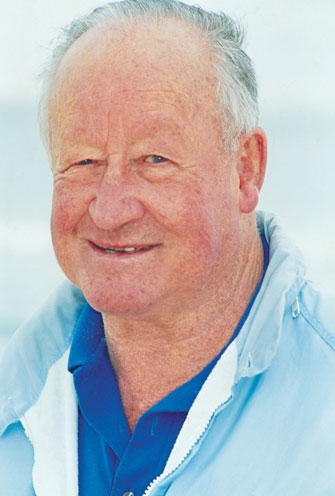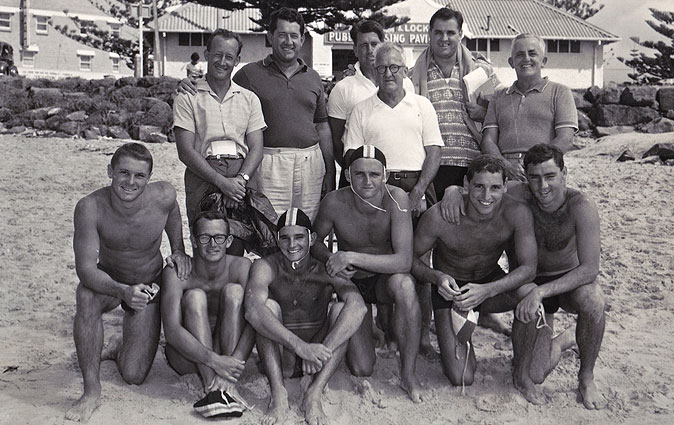THE EARLE OF KIRRA GETS A FAREWELL FIT FOR A KING
AUSTRALIAN SURF LIFE SAVING, August 21, 2012: EARLE SMITH AM (1926-2012) – LIFESAVER, MENTOR, COACH AND A MAN WHO DID IT HIS WAY
 |
 |
More than 350 surf lifesavers from all walks of life converged on Kirra Beach this week to pay their last respects to legendary Australian surf lifesaver Earle John Smith AM, who passed away peacefully on the Gold Coast in the company of friends on August 7, aged 85.
Smith, or “Colonel Paton” to many on the beach, attracted a crowd rarely seen at such farewells and a man who held the respect of thousands of lifesavers around Australia, in particular on the Gold Coast and in Queensland.
Although he would not have agreed with the fuss that was made over him on what would have been his 86th birthday (Tuesday, August 21), Earle Smith was more than deserved of a send off befitting one of the movement’s most dedicated members.
There were tears and laughter as his closest colleagues and protégés recalled his unwavering personal support and a passion for a community service he lived every day of his life to better, recalling his direct manner coupled with a wry smile and spirited nature and font of knowledge.
Surf Life Saving Australia’s CEO Brett Williamson, past president of the SLSA of A and Queensland SLSA Ron Rankin, Queensland president Ralph Devlin, CEO John Brennan and Point Danger Branch CEO Kerrie Barnes were just some of the dignitaries who were front and centre as a who’s who of lifesavers, including a host of Australian and Queensland champions, who stood side-by-side to honour one of their own.
Past and present surf craft including two traditional surf boats manned by members of his two clubs, his beloved Kirra Beach and the Currumbin Beach Vikings; IRBs and jet rescue boats with the Surf Lifesaver Rescue Helicopter hovering overhead formed the flotilla at the scattering of Earle’s ashes – as he had requested – in the waves off Kirra.
A member of the Order of Australia (AM), a member of Surf Life Saving’s Hall of Fame, a Life Member of Surf Life Saving Australia, Surf Life Saving Queensland, Point Danger Branch and Kirra SLSC, Queensland and Australian champion, Earle Smith had dedicated his life to the movement.
Although he worked full time for the CSIRO, every other minute of his life was spent serving the community through surf lifesaving, including his role as a “guinea pig” in the development and implementation of Expired Air Resuscitation (EAR).
In 1961 SLSQ Medical Officer, Dr Roger Bennett, recommended to a World Conference on resuscitation in Sydney the introduction of EAR.
Although the methods had at that time been widely adopted by most rescue and medical organisations, progress and acceptance of Expired Air Resuscitation in some areas was slow due to the fact that the aesthetic effect of direct contact had to be overcome.
Also there was the additional problem of many medical equipment manufacturers hawking various types of airway adjuncts and training aids that were not suitable for use in the basic teaching of the methods.
Dr. Bennett was not entirely happy with the progress so with the approval of the B.M.A. he organised a demonstration on anaesthetised volunteers from the Queensland Surf Life Saving Resuscitation Committee at St. Andrew’s Hospital Brisbane for the days 3rd – 10th November 1961 over two consecutive Saturdays.
To prove Expired Air Resuscitation would work Dr Bennett and Professor Tess Crammond (nee Brophy) arranged for four “guinea pigs” in the form of surf life savers. The “guinea pigs” were Earle Smith – Kirra, Bruce Campbell – Metropolitian Caloundra, Alan Doig – Burleigh and Jack Dearlove – Mooloolaba.
The world owes a huge debt to these men.
This was the era of the space race but it was also a time when drowning usually meant a death sentence.
In the days before the pioneering work of this committee, victims were revived using the Holger-Neilsen technique.
Breathing life into beach rescues, they were laid face down, their arms were drawn above their heads before rescuers pressed down on their backs.
The introduction of expired air resuscitation would transform rescue services and dramatically lift survival rates but it was a revolution slow in coming.
``We did it because we had to sell it,’’ said Earle Smith at the time “and the only way to sell something is to show it.’’
Earle Smith was a man who was devoted to the membership, in particular at Kirra and Currumbin, helping thousands of young Australians gain their lifesaving awards, coaching them in the surf and in the pool and looking after them like a sentinel on guard when they left the beach.
“Earle would help so many of us on the beach and also to ensure we were looking after ourselves away from the beach, making sure the younger ones were attending school, ensuring everything was ok at home and finding us jobs as well,” said Kirra life member Scott Byrnes.
‘He was one in a million who lived for surf lifesaving and who committed his life to the movement, always on hand to help, coach and mentor anyone who would listen.
“Earle coached, tutored, taught, mentored, and advised so many young men and women which has assisted them to be better citizens.
“Many of those were not just Kirra members and quite a number went on to win Pt Danger Branch, Queensland and Australian Championships or excel in their own right outside of the surf movement.”
Born in Wellington New Zealand on August 21, 1926 he joined Kirra Surf Life Saving Club in 1942 after his parents moved to Australia in 1940 amidst the Second World War which started to intensify.
He had been an active member of and champion swimmer with the Valley Swimming Club where quite a number of Kirra members such as Doug Brockhurst, Ron Marchant Ralph Ford-Johnson, and Harry King were members.
Brockhurst had been a mentor to a number of people including Earle. After he and a friend, future tennis champion Ian Eyre went to Kirra on holidays, Earle joined Kirra – a decision that would have a major bearing on the rest of his life.
Earle gained his bronze medallion that year. He recalls that members watched for sharks from the top of Kirra Hill. Given that two club members had lost their lives in a tragic shark attack that had occurred at Kirra five years earlier that was not surprising.
Shortly after his 18th birthday, in Sept 1944, Earle enlisted in the RAAF as a Clerk and even while training in the Toowoomba area competed in the services swimming carnivals. He was given the rank of Aircraftman Class 1 and was promoted to Leading Aircraftman in April 45. He did service on the island of Morotai off the New Guinea coast to the end of the war and proceeding. His main activities were in the investigation of missing servicemen. He was discharged in June 46 after returning home.
What followed has been dedication to Surf Life Saving which is hard to surpass.
Positions held by Earle in Surf Life Saving are as follows:
Kirra SLSC:
Honorary Register:1945-1946; Chief Instructor:1948-1952; Vice Captain
1950-52 & 1960-63; Club Captain: 1952-1958 & 1959-60; Deputy President:1963-1965
Point Danger Branch:
Honorary Secretary – Board of Examiners: 1948-1949; District Supervisor: 1950-1952; Deputy Superintendent:1956-1959;
Superintendent 1959-1966; President:1993-96 &1998-2003; Patron:1998-2000
Surf Life Saving Queensland:
Press Correspondent:1959-1960; Deputy Superintendent:1967-1971; Superintendent:1971-1978; Deputy President:1978-1988; State Councilor:1993-1996 & 1998-2003.
Surf Life Saving Australia:
Gear Research & Development Officer:1976-1984; Australian Championships Sectional Referee:1966-1986.
 |
THE EARLE OF KIRRA CREW: (Back row L-R): Rear: Earle Smith, Jack McMaster, Jack Dearlove, Harry Wymer, Maurie Webb, Bob Bryden
Front: Bob Carson, Graham Byrnes, Roger Wickham (Tracey Wickham's father), Peter Wippell, Bob Byrnes, Ken Wiles
He was a member of the famed Kirra 1947 Australian Gold Medal R&R team where Ron Marchant was the only beltman to reach the boys in the allotted time of 10 minutes.
Earle recalled a Sydney member remarking that there score was the highest to win but he rejoined with ‘and you couldn’t even make it’.
In those times it was an Anathema to southern clubs for a team from Queensland to win the Association R&R premiership.
Coach Brockhurst recalled the team bringing their patient out of the water to the resounding cheers of their supporters on the beach and wearing smiles as big as Kirra Beach – whatever they ‘drilled’ from that point was irrelevant as they had already won. They were the first team to take the title away from Sydney based clubs.
He was a member of the Queensland Surf Team in 1954 and managed the Queensland Surf Team in 1964.
In the pool Earle was the Queensland U18 200 metres freestyle swimming champion.
He would later go on to be a successful swimming coach training squads at the Valley Pool and Langlands Park.
Besides the many positions and recent ill health Earle still remained engaged in the examination of annual proficiency awards.
One of his defining moments came in 1967 and the rescue in mountainous seas off North Kirra beach when Kirra members Vic Arnall and Jeff Callaghan, with Wren Bligh and John Cunningham took part in a three-hour rescue operation of two fellow lifesavers. Earle co-ordinated that rescue. Both Jeff and Vic received bravery awards. Those were the days before helicopters, jet boats and IRB’s (rubber inflatables).
He believed the nipper movement had become and will continue growing in forming a significant part of what will keep surf lifesaving strong in the future. He also believed that the role of women in lifesaving will continue to grow and will also keep surf life saving strong.
Earle enjoyed immensely his life at Kirra, where he retired, and felt fortunate to have been honoured in so many ways but for him always trying to do your best and saving a life was always the most important part of it all.
An iconic lifesaver who will be remembered as a man who did it his way, leaving a legacy that will live on forever.
* Compiled by Ian Hanson with all research supplied with thanks by Kirra SLSC.